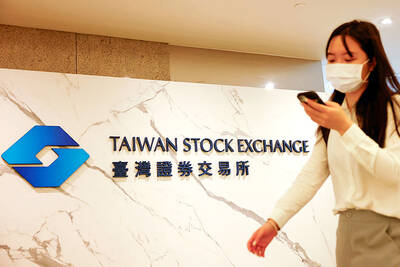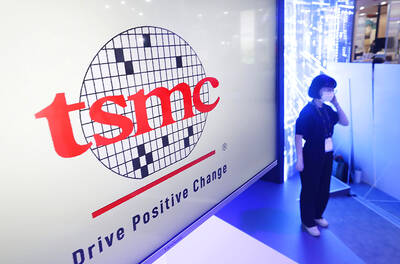The US Federal Reserve is gearing up to announce its first interest rate cut in more than four years on Wednesday, with policymakers expected to debate how big a move to make less than two months before the US presidential election.
Senior officials at the US central bank including Fed Chairman Jerome Powell have in recent weeks indicated that a rate cut is coming this month, as inflation eases toward the bank’s long-term target of two percent, and the labor market continues to cool.
The Fed, which has a dual mandate from the US Congress to act independently to ensure stable prices and maximum sustainable employment, has repeatedly stressed it would make its decision on rate cuts based solely on the economic data.

Photo: Reuters
The debate among policymakers tomorrow and on Wednesday would likely center on whether to move by 25 or 50 basis points. However, a rate cut of any size would be the Fed’s first since March 2020, when it slashed rates to near-zero to support the US economy through the COVID-19 pandemic.
The Fed started hiking rates in 2022 in response to a surge in inflation, fueled largely by a post-pandemic supply crunch and Russia’s war on Ukraine. It has held its key lending rate at a two-decade high of between 5.25 and 5.50 percent for the past 14 months, waiting for economic conditions to improve.
Now, with inflation falling, the labor market cooling and the US economy still growing, policymakers have decided that conditions are ripe for a cut.
Policymakers are left with a choice: Making a small 25 basis-point cut to ease into it, or a more aggressive cut of 50 basis points, which would be helpful for the labor market, but could also risk reigniting inflation.
“I think that in advance of the November meeting, there’s not quite enough data to say we’re in jeopardy on the employment side,” said Alicia Modestino, an associate professor of economics at Northeastern University, who was previously a senior economist at the Federal Reserve Bank of Boston. Analysts see the smaller cut as a safe bet.
“The Fed likes predictability,” Modestino said. “It’s good for markets, good for consumers, good for workers,” Modestino said.
“So a 25 basis point cut now, followed up by another 25 basis point cut in November after the next round of economic data, offers a somewhat smoother glide path for the economy,” she added.
While analysts overwhelmingly expect the Fed to start cutting this month, there is less clarity about what comes next. The Fed would shed some light on the issue on Wednesday, when it publishes the updated economic forecasts of its 19-member rate-setting committee — including their rate cut expectations.
In June, Federal Open Market Committee (FOMC) members sharply reduced the number of cuts they had penciled in for this year from a median of three down to just one amid a small uptick in inflation.
However, as inflation has fallen and the labor market has weakened, expectations of more cuts have grown.
“We continue to expect three rate cuts of 25bp [basis point] each at the remaining 2024 FOMC meetings,” Goldman Sachs Group Inc chief economist Jan Hatzius wrote in a note to clients published on Thursday.
Traders also see a greater than 99 percent chance of at least four more cuts next year, which would bring the Fed’s key lending rate down to between 3.5 and 3.75 percent — 175 basis points below current levels.

ADVANCED: Previously, Taiwanese chip companies were restricted from building overseas fabs with technology less than two generations behind domestic factories Taiwan Semiconductor Manufacturing Co (TSMC, 台積電), a major chip supplier to Nvidia Corp, would no longer be restricted from investing in next-generation 2-nanometer chip production in the US, the Ministry of Economic Affairs said yesterday. However, the ministry added that the world’s biggest contract chipmaker would not be making any reckless decisions, given the weight of its up to US$30 billion investment. To safeguard Taiwan’s chip technology advantages, the government has barred local chipmakers from making chips using more advanced technologies at their overseas factories, in China particularly. Chipmakers were previously only allowed to produce chips using less advanced technologies, specifically

BRAVE NEW WORLD: Nvidia believes that AI would fuel a new industrial revolution and would ‘do whatever we can’ to guide US AI policy, CEO Jensen Huang said Nvidia Corp cofounder and chief executive officer Jensen Huang (黃仁勳) on Tuesday said he is ready to meet US president-elect Donald Trump and offer his help to the incoming administration. “I’d be delighted to go see him and congratulate him, and do whatever we can to make this administration succeed,” Huang said in an interview with Bloomberg Television, adding that he has not been invited to visit Trump’s home base at Mar-a-Lago in Florida yet. As head of the world’s most valuable chipmaker, Huang has an opportunity to help steer the administration’s artificial intelligence (AI) policy at a moment of rapid change.

TARIFF SURGE: The strong performance could be attributed to the growing artificial intelligence device market and mass orders ahead of potential US tariffs, analysts said The combined revenue of companies listed on the Taiwan Stock Exchange and the Taipei Exchange for the whole of last year totaled NT$44.66 trillion (US$1.35 trillion), up 12.8 percent year-on-year and hit a record high, data compiled by investment consulting firm CMoney showed on Saturday. The result came after listed firms reported a 23.92 percent annual increase in combined revenue for last month at NT$4.1 trillion, the second-highest for the month of December on record, and posted a 15.63 percent rise in combined revenue for the December quarter at NT$12.25 billion, the highest quarterly figure ever, the data showed. Analysts attributed the

Taiwan Semiconductor Manufacturing Co’s (TSMC, 台積電) quarterly sales topped estimates, reinforcing investor hopes that the torrid pace of artificial intelligence (AI) hardware spending would extend into this year. The go-to chipmaker for Nvidia Corp and Apple Inc reported a 39 percent rise in December-quarter revenue to NT$868.5 billion (US$26.35 billion), based on calculations from monthly disclosures. That compared with an average estimate of NT$854.7 billion. The strong showing from Taiwan’s largest company bolsters expectations that big tech companies from Alphabet Inc to Microsoft Corp would continue to build and upgrade datacenters at a rapid clip to propel AI development. Growth accelerated for